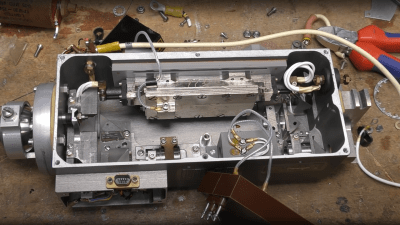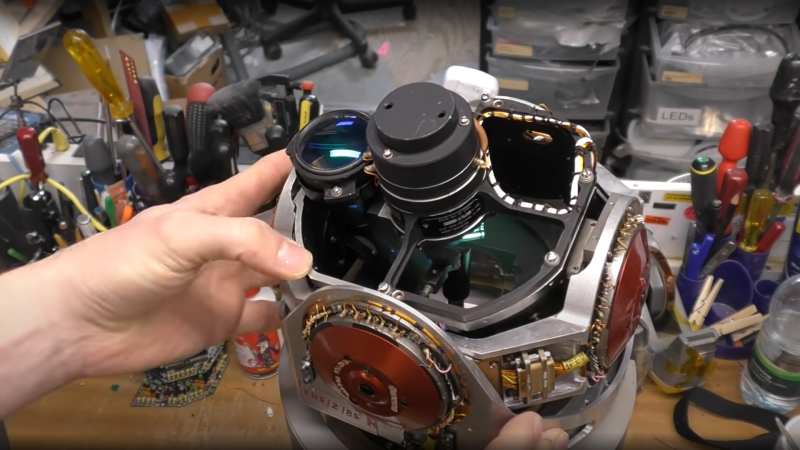Those of use hailing from the UK may be quite familiar with the Royal Air Force’s Tornado fighter jet, which was designed to fight in a theoretical nuclear war, and served the country for over 40 years. This flying deathtrap (words of an actual serving RAF fighter pilot this scribe met a few years ago) was an extremely complex machine, with state-of-the-art tech for its era, but did apparently have a bit of a habit for bursting into flames occasionally when in the air!
Anyway, the last fleet is now long retired and some of the tech inside it is starting to filter down into the public domain, as some parts can be bought on eBay of all places. [Mike] of mikeselectricstuff has been digging around inside the Tornado’s laser head unit, which was part of the bomber’s laser-guided missile subsystem, and boy what a journey of mechanics and electronics this is!

This unit is largely dumb, with all the clever stuff happening deep in an avionics bay, but there is still plenty of older high-end tech on display. Using a xenon-discharge-tube pumped yttrium aluminum garnet (YAG) laser, operating in pulsed mode, the job of the unit is to illuminate the ground target with an IR spot, which the subsequently fired missiles will home on to.
Designed for ground-tracking, whilst the aircraft is operating at speed, the laser head has three degrees of moment, which likely is synchronized with the aircraft movement to keep the beam steady. The optical package is quite interesting, with the xenon tube and YAG rod swimming in a liquid cooling bath, inside a metal housing. The beam is bounced around inside the housing using many prisms, and gated with a Q-switch which allows the beam to build up in intensity, before be unleashed on the target. Also of note is the biggest photodiode we’ve ever seen — easily over an inch in diameter, split into four quadrants, enabling the sensor to resolve direction changes in the reflected IR spot and track its error. A separate photodiode receiver forms part of the time-of-flight optical range finder, which is also important information to have when targeting.
There are plenty of unusual 3-phase positioning motors, position sensors, and rate gyros in the mix, with the whole thing beautifully crafted and wired-up military spec. It is definitely an eye opener for what really was possible during the cold war years, even if such tech never quite filtered down to civilian applications.
We’ve seen a few bits about the Tornado before, like this over-engineered attitude indicator, and here’s the insides of an old aircraft QAR (Quick Access Recorder)
Thanks [Zane] for the tip!
















The mini gyros are so cute!
Yeah – truly watch-makers mechanics. Although they are not very accurate (some ten degrees drift per hour) compared to navigation/tactical grade (<0.05°/h) – but still way better than the MEMS devices knows from our smart phones (often 1°/second).
“a xeon discharge tube”
That was really future tech back then, 1979. (Intel introduced it reportedly 1998 [1] ;^)
I think that was meant to be “xenon”. Somewhat scary to see how a corp’s PR messes with our brains.
[1] https://en.wikipedia.org/wiki/Xeon
lol. What a dumb typo! In my defence, I was looking at a pair of Xeon processors on my desk, as they’re surplus so I’m going to throw them on eBay. Multitasking is not my thing – am engineer.
Well now you know how you need to ship those Xeons…. in a Xeon discharge tube ;-)
“… a bit of a habit for bursting into flames occasionally when in the air!”
Funnily enough that was a particular predilection of the English Electric Lightning. If an engine fire was signalled the pilot had just moments to decide whether to eject before the flying controls burned through.
My favourite quote in such a situation, pre-flight briefing in a dual-cockpit trainer craft used to give VIPs a supersonic joyride, was “If I say ‘Eject, Eject’ do not say ‘What?’ as you will be talking to yourself!”
They must have used Lucas for their wiring.
use | us
It’s always interesting to see inside things like this.
I remember making a tiny direction error sensor that worked in a similar way when I was younger. It consisted of a camera film canister, painted black inside, with a tiny hole in the lid to act as a pinhole camera. In the bottom of the film canister, I stuck nine LDRs. I guess I’d use photo transistors these days. It was originally for a rather over engineered solar tracker but it ended up being used by a fairly unsuccessful little robot.
When I see things like this laser module, I can’t help but wonder, what else isn’t trickling down.
I vaguely remember reading somewhere about one of the first self-guided missiles (air-to-air iirc) that used pretty much the same method as you did. The operator had to line up the target in front of the sun before firing…! If the sun light touched one of the eight sensors not in the middle, the missiles steering system was activated to adjust.
I can’t for the life of me find an article on it right now tough…..
” It is definitely an eye opener for what really was possible during the cold war years, even if such tech never quite filtered down to civilian applications.”
Probably didn’t need, or want to pay for it.
Isn’t the four-quadrant photodiode precisely what’s used in CD and other optical disc mechanisms to track the laser on the disc surface?
Pretty much. Often time a 4-quadrant plus rod-lens arrangement is used for focus tracking. With 4-quadrants, all signals being equal means perfect focus. 2 diagonal diodes (with more power than the other two) indicate focus too-close or too-far (depending on which pair).
All 4-quadrants taken together for the signal to the decoder to recover the music.
Usually in addition to the 4-quadrant, there were an 2 side diodes used for tracking. One left, one right. Similarly, both equal intensity means you are right on track.
hmm. I wonder if these could be hacked into an alignment system for my CNC routers.
Looking at such tech always leaves one speechless. We are so used to seeing things built down to a price. But these types of fields where there is seemingly no budgetary restriction… oof. Beautiful, in kind of a macabre way.
Exactly, I think the same. It’s somehow a bit macabre that military “stuff” shows what mankind is capable of if profit/capitalism is left out. Makes someone wish that public “stuff” was made with the same kind of dedication.
And also quite amazing, that this LRMTS (Laser Ranger and Marked Target Seeker) shares some components with the inertial navigation platforms developed by Ferranti some years earlier. Esp. the gimbal construction, the unique brushless (we are in 1970!) motors and the slip rings are identical. See my video on the INS systems, https://www.youtube.com/watch?v=-EQqfxiGgd8&t=284s. The platform was widely used not only on Tornado, but also on Nimrod (submarine hunter), Phantom (English version), Harrier (Famous vertical take-off plane), Concorde (prototype) and it made the Ariane 1-3 the most accurate space launcher of its day.
Ahh, and the SEPECAT Jaguar also used this laser ranger where it was part of the NAVWASS system (see time code 4:23, lower left corner: https://youtu.be/v-gF5g0nnoE?t=242).